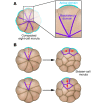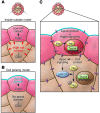Making the blastocyst: lessons from the mouse
- PMID: 20364097
- PMCID: PMC2846056
- DOI: 10.1172/JCI41229
Making the blastocyst: lessons from the mouse
Abstract
Mammalian preimplantation development, which is the period extending from fertilization to implantation, results in the formation of a blastocyst with three distinct cell lineages. Only one of these lineages, the epiblast, contributes to the embryo itself, while the other two lineages, the trophectoderm and the primitive endoderm, become extra-embryonic tissues. Significant gains have been made in our understanding of the major events of mouse preimplantation development, and recent discoveries have shed new light on the establishment of the three blastocyst lineages. What is less clear, however, is how closely human preimplantation development mimics that in the mouse. A greater understanding of the similarities and differences between mouse and human preimplantation development has implications for improving assisted reproductive technologies and for deriving human embryonic stem cells.
Figures




References
-
- Bacharova R. Gene expression during oogenesis and oocyte development in mammals. Dev Biol (N Y 1985). 1985;1:453–524. - PubMed

